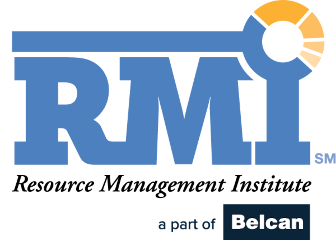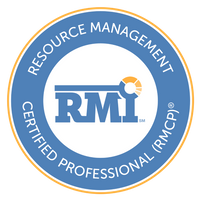The discipline of resource and workforce management is growing quickly as human capital-intensive organizations respond to unprecedented market conditions. Labor shortages, the great resignation, pandemic implications accelerating remote work, rising labor costs, generational changes, and more are putting a spotlight on our capabilities to manage talent efficiently and effectively. At the very heart of our processes to manage resources is the Resource Manager. This mission critical role has gone from being a specialty role to now being clearly launched into the mainstream. From a survey of 45 companies done in 4Q/2021 we see that companies are making solid investments in people (resource and workforce managers) to manage their processes for resource and workforce management.
Organizational size (in # of resources)
| 0-50 | 51-100 | 101-200 | 201-500 | 501-999 | 1000+ | |
| Average Number of RMs in Organization | 2 | 7 | 4 | 7 | 8 | 28 |
Without a doubt, investments in resource and workforce management talent is growing from our prior survey, fueled by the many benefits of improved resource management outcomes. Consequently, the task of finding good resource and workforce managers is also becoming more difficult due to a growing scarcity of these talented people. From the same research quoted above:
Finding skilled Resource Managers is:

Interesting to note that not one respondent indicated ‘not hard to find’. That kind of says it all. And while we don’t have any survey data to share on retention of these RM/WFM professionals, from the calls and emails we are getting here at the Institute, retention has become a significant issue as the industry has entered a stage of high RM/WFM turnover in the battle for scarce talent.
If you have read our 3-part series on employee engagement (downloadable from the RMI website whitepaper library) you will have learned that throwing money at these people is not the answer. There are more effective and affordable ways to approach the problem and that is what we hope our members will gain.
In this article, the RMI will provide some insights into 3 steps your company can take to retaining the best resource managers. Those 3 steps are:
- Hire right from the start – what to look for in a good Resource/Workforce manager including key skills and attributes for what our research and experience tell us is the winning resume for a good RM/WFM
- Show them a career path – some insights on the industry status for RM/WFM career pathing and what you can do to provide an attractive ladder for the RM/WFM professional
- Ongoing training and development – identify skills development needs for RM/WFMs and some options on how to provide that development
Winning the talent war for RM/WFMs is particularly important overall to any enterprise as it lays the foundation for how you plan to manage the deployment of all of your project-based resources.
Step 1 of the 3-step plan to retain the best resource/workforce managers – hire right from the start. This probably seems like a no brainer as it is a necessary component of any new hire for any role. The key here is to be sure you have the latest in research on what are the characteristics and skills needs of today’s successful resource and workforce managers.
In a 4Q/2021 research report, the RMI asked employers ‘when hiring resource managers, what skills are you primarily looking for?’ and here is what they said:

The research also went on to find that, when we asked resource managers what their backgrounds were before accepting a new role as a resource manager, few had any prior resource/workforce management experience. This is undoubtedly because the industry has a shortage of these skills so the industry is in the process of building new resource manager talent. Interesting but not surprising was the focus on soft skills as depicted in the research. The role of the RM/WFM puts them in a position where they have to communicate effectively with a broad range of constituents including execs, delivery teams, finance, HR, and more. Good communication and soft skills therefore become vital. Overall, we agree with what respondents are focused on for RM/WFM hires.
Some other necessary characteristics of a good RM/WFM that the RMI has found are helpful include good organizational skills, analytical skills, and a background in the service environments they are targeting for resource/workforce management.
The RMI has published the following summary for RM/WFMs to be successful, visualizing the need for a well-rounded set of skills as depicted below:
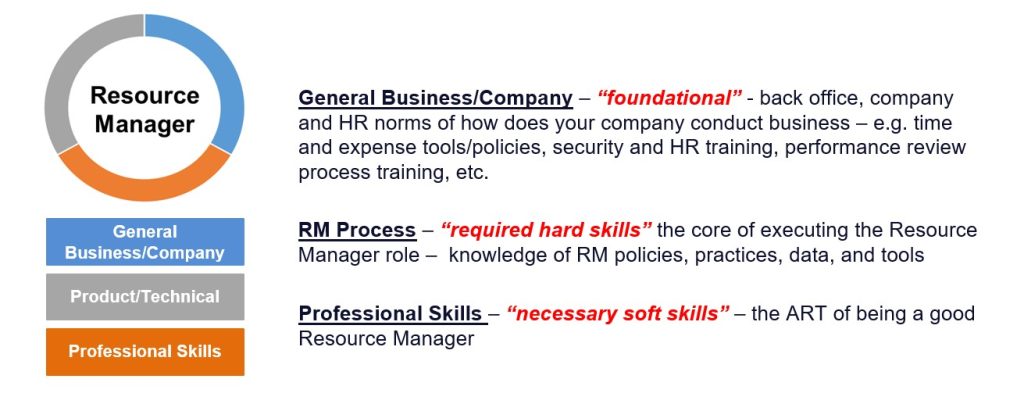
If you cannot find candidates with these skills/backgrounds, then pursuit of candidates that have the right characteristics and then training them for the role makes sense. The RMI can provide training for both RM Process and Professional Skills specifically targeted at the role of the RM/WFM.
Step 2: Show Them a Career Path
Companies providing career paths for employees has never been more important. Anne Fulton, author of The Career Engagement Game and founder of Fuel 50, co-presented at an HR Tech Conference a presentation titled, “The Next Frontier of Uberization at Work: Career Pathing for a More Engaged Workforce.” Thanks to that power shift between workers and organizations – due to the current talent shortage – employers need to redesign a career experience to fit the transformed world in order to combat rising quit rates and falling engagement scores, Fulton said. Indeed, according to Randstad, 86 percent of employees leave their jobs due to a lack of career development.
When applied to the role of the Resource Manager, the RMI believes this not only applies, but is amplified due to the relatively nascent existence of the RM role relative to other more established industry roles.
Even more concerning, in a recent RMI research report from 4Q/2021, companies have a long way to go to catch up with other more established roles. When asked ‘does your company have defined career path for RMs?’ this is what we learned:

Larger companies due to their size and scale perhaps have more alternatives for how to do this, but even a small company can find creative ways to establish a career path. Some best practices and ideas for creation of career paths for RM/WFMs include:
- People want to be part of something important. Make sure the role of the RM/WFM is given some organizational prominence. Establishment of a Resource Management Office (RMO) function, with responsibility in line with the important impact a well-run RMO can yield, will speak volumes about why someone might want to be part of the RMO. Where the function reports will also say a lot about the importance of the function.
- Consider developing traditional tiers of the role e.g. associate RM, RM, senior RM, and the like.
- For the larger RMO, the various functions within the RMO can provide opportunity for step ladder opportunities like resource planning, process development and governance, and of course the RMO leader role as well.
Step 3: Ongoing Training and Development
As shared earlier, ongoing career development is a known driver of retention, especially for the new generations. In this article I will not attempt to define what is hopefully obvious but a good starting point for this is a manager and employee doing some formal planning work whereby the employee shares perspectives on career desires, self-assessed strengths and weaknesses, and other career planning related matters. Once employee and manager agree on a plan, then they can begin mapping appropriate training, experience building, mentoring and other activities to the career plan. From an RMI perspective, we can help employers with the last 2 levels depicted below:
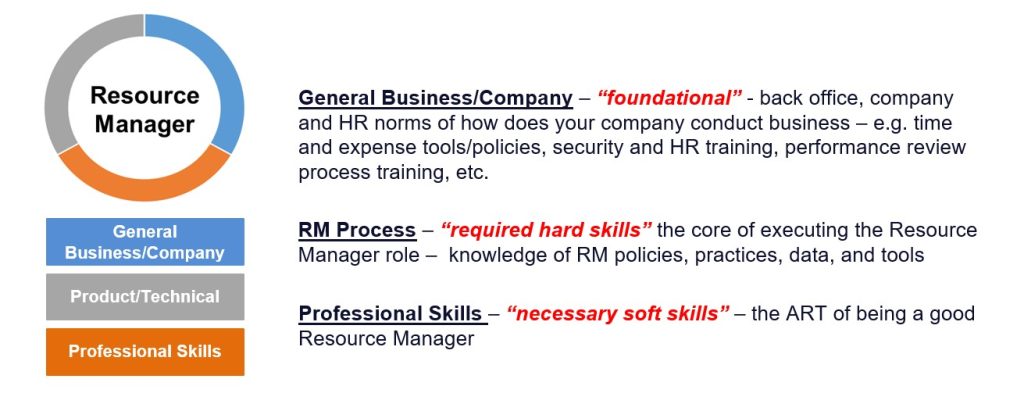
The RMI has training to assist with these last two layers as follows:
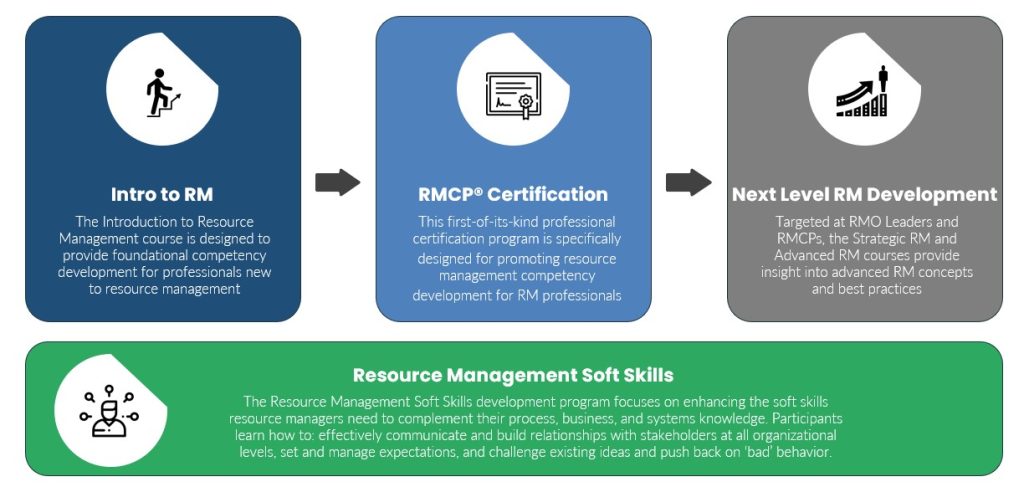
You can learn more about these training offerings by visiting our resource management classes.
In summary, the role of the RM/WFM is rapidly growing, and the discipline of resource and workforce management is becoming more important to any project-based employer. Because of the enormous impact effective resource and workforce management can have on any company, building a stable, professional, and competent RM/WFM function is mission critical. Focus on retaining the best and brightest with the 3-steps defined in this article!
